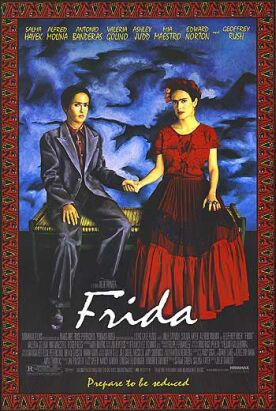Frida
As the revolutions of the 20th century begin to recede into the past, all that remains of them is the aesthetic pleasure we continue to take in their audacity — their “outrageousness,” to use a current term of approval. Julie Taymor’s Frida, an account of the lives and loves of Frida Kahlo (Salma Hayek) and Diego Rivera (Alfred Molina), has little to tell us about its heroes’ art or their politics or even their sex lives as such, but it is endlessly fascinated by their outrageousness, both to each other and to the proprieties of the 1920s and 1930s.
The subject is in this respect well-suited to the flamboyant style of Miss Taymor, whose Titus is one of the most impressive and memorable of recent cinematic readings of Shakespeare. Here she impresses again with a series of tableaux vivants based on Frida Kahlo’s surrealist paintings and featuring Miss Hayek made up to look uncannily like the artist in her self-portraits. Most memorable, perhaps, is the image that arises out of the trolly-bus accident which severely injured Miss Kahlo in her youth and caused her serious health problems for the rest of her short life. We see her looking like a surrealist icon: naked, pierced through with a railing from the bus and covered in gold leaf that a fellow passenger had been taking to decorate the cathedral ceiling.
But the visual razzmatazz, though it is an amusing counterpart to the soap opera of injuries and infidelities overcome and famous people slept with, cannot conceal the yawning absence at the film’s center, which is a necessary sense of detachment from the revolutionary ferment of seventy or eighty years ago. Anyone who knew no more of the period than is revealed to us in this film might suppose that Communism was a great success, its vision of the future as radiant as it seemed to Frida Kahlo and Diego Rivera rather than the ghastly charnel house that it proved to be again and again. When Leon Trotsky (Geoffrey Rush), who became one of Frida’s lovers, describes himself in Mexico as being “alone with few friends or resources against the world’s biggest killing machine,” there is no hint that the killing machine was partly of his construction.
Likewise, both the surrealist style of Frida Kahlo and the triumphalist socialist- realism of Diego Rivera now look to be far more of their time and place than Impressionism, say, or Cubism, and hardly the great and hopeful gateway to liberation that they seemed to many at the time. When Nelson Rockefeller (Edward Norton) orders the destruction of Rivera’s mural in Rockefeller Center because the latter refused to paint out its portrait of Lenin, it is hard to pretend that the thing would not have been a joke or an embarrassment if it had survived. The post-modernists would of course have loved it, but only in the same way that they love the now-discarded monumental sculptures of Communist placeholders from Eastern Europe.
It is not improbable that the omission of any sense of historical perspective is deliberate. Miss Taymor is a smart postmodernist herself, and she no doubt wants to recreate the excitement of those revolutionary times while keeping from us the terrible secret of the disappointment of all its hopes. The only revolution that now appears to have been lasting is the sexual one, and even that is very far from being unproblematic. The film attempts to keep its shining example before our eyes while at the same time celebrating the Kahlo-Rivera love affair — they married, divorced, then married again — by attempting to make an unconvincing distinction between loyalty and fidelity.
Frida herself does not believe in it when she catches Diego, who describes himself as “constitutionally incapable of fidelity,” with her sister (Mia Maestro). It would have been interesting if the film had sought for the wellsprings of forgiveness between two such committed atheists. Instead, it seems content to leave us with a vague impression that the love story in its foreground is connected to the revolutionary aspirations in its background without showing any interest in what that connection might be. The result is, for all its creativity, a disappointingly routine biopic in which a semi-prurient curiosity about the private lives of its celebrity personae is the only justification for its existence.
Discover more from James Bowman
Subscribe to get the latest posts to your email.








